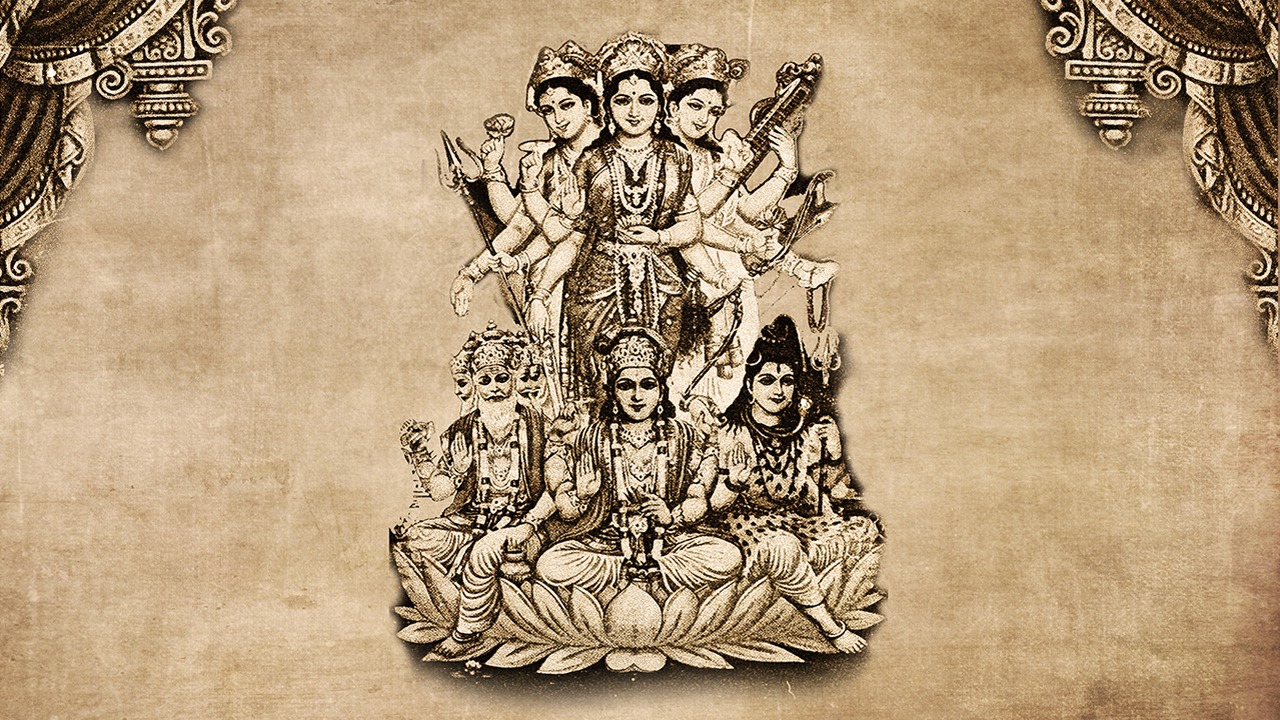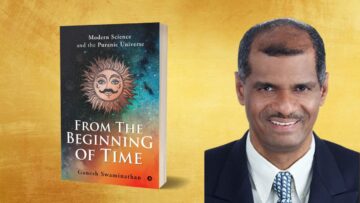Anthology – The Tridevi-s and Trimurti-s
The Srishti-Karta, the Sthiti-Karta & the Laya-Karta
There is no Bharateeya who does not know Brahma, Vishnu, Maheshwara – the Trimurti-s or the Trinity of Sanatana Dharma. Just as we know Ramayana and Mahabharata without being taught, we also know the Trimurti-s before we begin a formal learning journey. They are omnipresent physically and otherwise. They are never without Tridevi-s – Saraswathi, Lakshmi and Parvathi. They are together also known as Adi Parashakti or Mula-Prakriti. Bharateeya conversations are nearly impossible without a reference to them and their ‘Daiveeka’ performances – even if one has strayed beyond the Shraddha of the Tradition. Sanatana Dharma has evolved around the Trimurti-s and Tridevi-s, and their divine functions – Srishti, Sthiti and Laya.
Explicit references to them start from the Vedas itself. While the Modernists argue that the Trimurti-s and Tridevi-s are Pauranic and not Vaidika, the Tradition does not agree with this distinction. Suffice to say that there is a significant continuity between the Vedas and the Puranas as far as the Trinity is concerned. Certainly so, as far as the performative Tradition is concerned. The Vedas present the Devata-Tatva in a complex form of First Principles of the Cosmic Universe. The Puranas present them in their manifestation as deities, the Murti-s and Devi-s, and in the form of stories. The former requires Sages and higher order Vaidika-s to appreciate. The rest of us, living on the material plane, relate to the First Principles or the Tatva only through Murti-s/Devi-s and stories. The Modern world, anchored more on intellectual thought and model thinking, is yet to develop an explicit instrument to experience the Tatva. Thus, a direct entry into the Vedas is more difficult. Hence, in our times, the Puranas ought to be our first entry point to go beyond into the world of Greater Truth.
We know the story or the narrative dimension of the Puranas well. However, just as the Vedas, the Puranas too have a Tatva dimension. They are less poetic or mystic than the Vedas. Presented as conceptual frameworks in simple verse, Vaidika Tatvas in the Puranas are more accessible from the material/intellectual plane of our times. The initial sections of most Puranas have a lot of such Tatva-s. In particular, Srishti-Sthiti-Laya perspective is presented in great detail in many Puranas in their initial sections. In different Puranas, this assumes different emphasis and narrative. Depending upon the prominent Trimurti/Tridevi of the particular Purana, the Srishti-Sthiti-Laya narrative changes. Pauranic stories present different Srishti-Sthiti-Laya functions performed by Trimurti-s/Tridevi-s in different Puranas.
The Trimurti/Tridevi stories and formal narratives of Srishti-Sthiti-Laya associated are the foundation of Sanatana Dharma. Their enormity is often lost because they present as distinct stories spread across Puranas. However, they represent the fundamental dynamic of the universe. Dharma is all about being in line with this fundamental dynamic. Human life must lay within the boundaries of the principles of Srishti-Sthiti-Laya. The Universe of life carved by Trimurti/Tridevi-s is the boundary within which human life must thrive in Dharma. The ones who seek to cross are the Rakshasas. Indra and other Devatas protect critical points in this universe and ensure that Dharma is protected. For us to understand this universe better, the Trimurti/Tridevi stories need to be brought together from across the Puranas to present the complete universe. They must be presented in relation to the Srishti-Sthiti-Laya concepts that are present in the Puranas.
Towards this Indic Academy calls for an Anthology in collaboration with “Heritage”, a not for profit Trust, located in Bangalore. Heritage led by Smt. Vijayalakshmi Vijayakumar, organises annually “Gudiya Sambhrama” the Temple Festival in various temple venues across Bangalore every January. The Gudiya Sambhrama of 2024, which literally means the ecstatic joy of the temple/being in a temple, will be preceded by a year long celebration of important festivals in various temples of Bangalore. The theme of this year is ‘Srishti-Sthiti-Laya’. As part of this theme, An Anthology of stories on Trimurti & Tridevi-s, with a focus on the Srishti-Sthiti-Laya tatva, will be published by Indic Academy jointly curated by Shivakumar GV, Scholar-in-Residence, Indic Academy and Vijayalakshmi Vijayakumar, also the co- founder and Director of Centre for Soft Power.
We call upon Indic Writers, Purana Enthusiasts to draw Srishti-Sthiti-Laya related stories from the Puranas. The Stories should meet the following criteria.
- Stories should be about any one or more of the Trimurti-s/Tridevi-s
- Stories should throw important light on the Srishti-Sthiti-Laya Tatva
- Stories should not be more than 1200 words each
- Stories should be from one the 18 Mahapuranas or Ramayana and Mahabharata
- Stories must be faithful to the scriptural accounts but written in the modern short story form in a Dharmic voice. Within this boundary, authors are encouraged to assume creative liberty and imagination.
- Stories must present the universal truth in our Puranas and at the same time must be in a form that is relatable from the realities of our world
Authors whose stories are selected will be taken through a series of Writing/Editing exercises including workshops finally culminating in a book that will be published by November 2023 just in time for the Gudiya Sambhrama Festival of January, 2024. The proposed schedule is as follows.
- Anthology Announcement – March 2023
- Stories submission final date – May 2023
- Shortlisted Stories announcement – June 2023
- Writing Workshop – July 2023
- Author Rewriting – August 2023
- Final Editing – September 2023
- Publishing – November 2023
We call upon aspiring Indic Authors to submit their Trimurti/Tridevi/Srishti-Sthiti-Laya stories to namaste@indica.org.in






